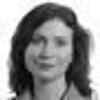Mohsin Hamid's new novel How to Get Filthy Rich in Rising Asia is, as its title suggests, located in the curiously unspecified terrain of 'rising Asia', and in uncertain times. Reviewers so far have reached for weighty comparisons with Tolstoy, Alger and Fitzgerald, but Hamid's stylistic experimentation stands out as the most intriguing characteristic of this, his third novel. No character has a name, perhaps to lend the universality ironically claimed through the book's takeoff of the self-help genre. And the novel's playful self-referentiality is almost postmodern, signalled in the penultimate chapter title, 'Focus on the Fundamentals', which recalls Hamid's 2007 Booker-nominated The Reluctant Fundamentalist and a Paris Review story excerpted from it.
As in all his books so far, Hamid employs the second-person address, a technique he discusses in a recent Guardian article. In The Reluctant Fundamentalist, the reader was put in the position of 'you', a burly American interrogator, and therefore uncomfortably implicated in US foreign policy; Moth Smoke, in contrast, gave its readership the unusual vantage point of a judge presiding over the protagonist's murder trial. Similarly, How to Get Filthy Rich in Rising Asia's two main characters are 'you' and 'the pretty girl'. Occasionally, Hamid even employs the perspective of a drone pilot, a 'reconnaissance satellite' or something even higher up (God?), and writes in a style influenced by the dizzying extrapolation techniques of Google Earth, zooming out from the city, revealing the systems above the systems, and showing that the self from the self-help book is just a tiny node within a vast constellation of networks.
You come from an archetypal subcontinental village, of feudal landlords, pot-carrying women and ruminating water buffalo. Yet what your father notices in this deliberately hackneyed pastoral scene is the hard labour behind it, and this makes him 'sniff mortality'. Because of hardship and fear of death (you contract hepatitis-E early on), most of the novel's countryfolk long, in the words of the opening chapter's title, to 'Move to the City'. When you relocate to a glittering, polluted metropolis which it becomes clear is a dematerialized twin of Lahore (although like the characters, it is never named), it seems as far from your village as 'subtropical jungle' lies from 'semi-arctic tundra'.
Once in the conurbation, you are exhorted by the mercenary self-help chapter headings to 'Get an Education' but not 'Fall in Love', because desire for the pretty girl, now a struggling model, could interfere with the making of your fortune. The pretty girl is the best female character Hamid has yet created, chain-smoking and claustrophobic in relationships, yet with a depth of feeling that makes her 'blurry . . . not entirely present' when apart from you.
As well as not falling in love, you should also avoid 'Idealists', a euphemism for the type of quasi-religious university extremist Changez may have become towards the end of The Reluctant Fundamentalist. However, in this megacity without governance or a welfare state, you must 'Be Prepared to Use Violence'. This imperative has an especially grim resonance today, given the arson attacks in the Christian district of Joseph Colony that recently shook Lahore. Your elevation to filthy richness and subsequent fall from grace are documented through your teenage DVD delivery job and an adult business venture selling boiled water repackaged for bottles and coolers, arriving at your 'Dance with Debt' and the 'Exit Strategy' this necessitates.
The novel recalls Othello's famous 'double time scheme', through which Shakespeare tricks the audience into accepting a temporality that shrinks and expands while he chronicles the doomed marriage of Othello and Desdemona. Similar time conjuration abounds in How To Get Filthy Rich in Rising Asia: the characters age and the plot spans at least six decades, but the social affairs, technologies and politics of Pakistan are pure twenty-first-century throughout, replete with mobile phones, bombings, drone attacks, bearded Islamists and covered women, even though Pakistan only began to Islamize during President Zia's despotic regime of 1977-88.
Hamid appreciates his past and dehistoricizes this 'not-Pakistan' knowingly, but when he writes, 'Television and radio . . . bring in some news of the city, usually frightening, but then that has always been the case', he homogenizes Pakistan as a place of timeless violence for his mostly Western readers, who may or may not overlook his ludic deception. At the start of the penultimate chapter, the narrator confesses
to certain false pretenses, to certain subterfuges that may have been perpetrated here, certain of-hands that may have been, um, sleighted.
So long as one heeds this warning about the novel's tongue-in-cheek approach and does not take it, as the Daily Beast review does, to be a 'record of human experience and geopolitical shift', then it is the sassy and gripping story of an everyman in a doppelganger of Lahore. But the real trick was getting the book to say so much - about love, ageing, class and globalization - under the pulpy self-help conceit. Read this book not to become filthy rich, nor to learn about an apparently rising Asia, but to admire the chutzpah of a gifted writer having fun with history.
